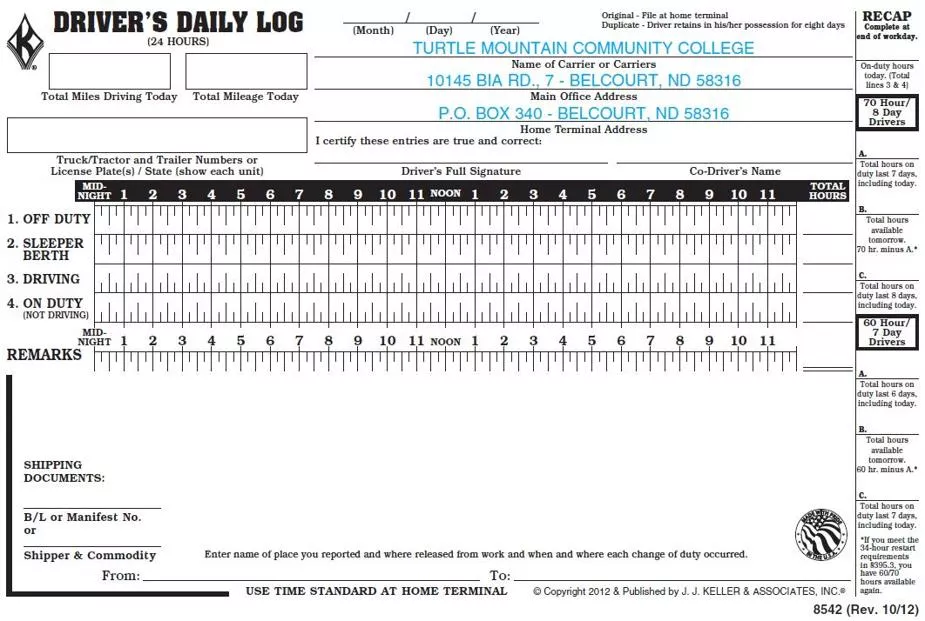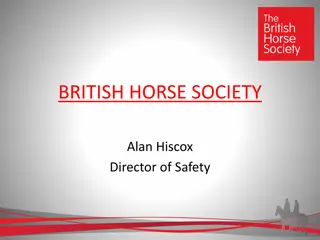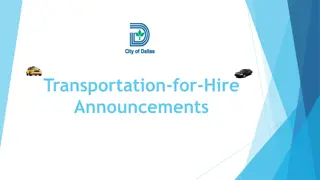Understanding Hours of Service Regulations for Commercial Drivers
Learn about the importance of complying with Hours of Service (HOS) regulations for commercial drivers, including rules, procedures for filling out log books, and avoiding penalties for violations. This course covers key aspects such as duty status, record-keeping, and applicable regulations for drivers and carriers.
Download Presentation

Please find below an Image/Link to download the presentation.
The content on the website is provided AS IS for your information and personal use only. It may not be sold, licensed, or shared on other websites without obtaining consent from the author. Download presentation by click this link. If you encounter any issues during the download, it is possible that the publisher has removed the file from their server.
E N D
Presentation Transcript
Log Book Hours of Service of Drivers This work is licensed under the Creative Commons Attribution 4.0 International License. To view a copy of this license, visit http://creativecommons.org/licenses/by/4.0/. This workforce solution was funded by a grant awarded by the U.S. Department of Labor s Employment and Training Administration. The solution was created by the grantee and does not necessarily reflect the official position of the U.S. Department of Labor. The Department of Labor makes no guarantees, warranties, or assurances of any kind, express or implied, with respect to such information, including any information on linked sites and including, but not limited to, accuracy of the information or its completeness, timelines, usefulness, adequacy, continued availability, or ownership.
Purpose The purpose of the Hours of Service HOS is to provide you the driver with the necessary information on the proper procedure in filling out a log book. It is important to know how to properly fill out a log book in order to avoid serious penalties and fines for being in violation. Also HOS is to keep you the driver from being fatigued and driving on the highway.
Objective By the end of the course you will: Know what are the rules and regulations that apply to filling out a log book How to fill out a log book Keep track of your hours for the day and week How to maintain your log book
Introduction The Hour of Service regulations are among the most often violated of the FMCSR. Although intentional violations account for a significant proportion of all citations, a lack of knowledge and understanding of the regulations, their applicability, and the driver s duty status record also result in many citations and fines.
Who must comply The HOS rules are applicable to all employees, and commercial motor vehicles which transport property or passengers in interstate commerce A commercial vehicle has a GVW, GVWR, GCW, or GCWR of 10,001 pounds or more; or Is designed to transport more than 8 passengers including the driver for compensations or more than 15 passengers including the driver not for compensation; or Transport hazardous material of a type and quantity which require placarding
Who must know the rules The Federal DOT places responsibility for compliance with the regulations on both the driver and carrier, as stated in Section 390.3 of the Federal Motor Carrier Safety Regulation (FMCSR) Every employer shall be knowledgeable of and comply with all regulations contained in this subchapter which are applicable to that motor carrier s operation. ( 390.3(e)(1)) Every driver and employee shall be instructed regarding, and shall comply with, all applicable regulations contained in this subchapter. ( 390.3(e)(2))
HOS On-Duty Time The term on-duty time is used continually in the hours of service regulations. Just what is the meaning of on-duty time? The FMCSR says in 395.2 that on-duty time includes all the time from the time a driver begins to work or is required to be in readiness to work until the time he/she is relieved from work and all responsibility for performing work.
On-Duty Time All time at a plant, terminal facility, or other property of a carrier or shipper, or on any public property, waiting to be dispatched, unless the driver has been relieved from duty by the motor carrier All time inspecting, servicing, or conditioning any motor vehicle at any time All driving time as defined by the term driving time All time loading/unloading a vehicle, supervising, or assisting in the loading/unloading, attending a vehicle being loaded/unloaded , remaining in readiness to operate a vehicle, or in giving or receiving receipts for shipments loaded/unloaded
On-Duty Time All time, other than driving time, in or upon a motor vehicle except for the following: Time spent resting in a sleeper berth as defined by the term sleeper berth Time spent resting in a parked vehicle except as provided in 397.5 and Up to 2 hours riding in the passenger seat immediately before or after at least 8 consecutive hours in the sleeper berth All time repairing, obtaining assistance, or remaining in attendance upon a disabled vehicle Performing any work in the capacity of, or in the employ or service of a motor carrier All time spent providing a breath/urine sample, including travel time to and from the collection site, in order to comply with testing requirements Performing any compensated work for any person who is not a motor carrier
The Limits 11 hours driving A driver may not drive a CMV for no more than 11 cumulative hours following 10 consecutive hours off duty.
The Limits 11 hours driving A driver may not drive a CMV for no more than 11 cumulative hours following 10 consecutive hours off duty. 14 hours on duty A driver may not drive a CMV after the end of the 14thconsecutive hour after coming on duty following 10 consecutive hours off duty. After July 1, 2013 driving is not permitted if more than 8 hours have passed since the end of the driver s last off-duty or sleeper berth period of at least 30 minutes
The Limits 11 hours driving A driver may not drive a CMV for no more than 11 cumulative hours following 10 consecutive hours off duty. 14 hours on duty A driver may not drive a CMV after the end of the 14thconsecutive hour after coming on duty following 10 consecutive hours off duty. After July 1, 2013 driving is not permitted if more than 8 hours have passed since the end of the driver s last off-duty or sleeper berth period of at least 30 minutes 60/70 hours on duty a driver may not drive CMV after having been on duty 60 hours in any 7 consecutive days or 70 hours in any 8 consecutive days
11 Hour Driving Rule Following 10 hours off duty, 11 hours of driving time are allowed. After 11 hours behind the wheel, a driver must obtain at least 10 hours off duty before driving again ( you may continue to work but may not drive) When there is an unforeseeable, adverse driving conditions are encountered, drivers will be allowed an extra two hours of driving to finish the run or reach a safe stopping place
14 Hour On-Duty Rule This rule states that a driver may not drive a CMV beyond the 14th consecutive hour after coming on duty, following 10 consecutive hours off duty A driver may continue to work after the 14thhour, but not drive The 14 hours are consecutive, so they include all driving, on-duty, any sleeper berth period less than 8 hours, and off-duty time accrued after coming on duty after a 10 hour break
Sleeper Berth The sleeper berth is a valuable option for drivers to cumulate the required off-duty time 395.1(g) says that the required 10 consecutive hours off-duty can be achieved by use of the sleeper berth A driver may split the sleeper berth with off-duty time to accumulate 10 consecutive hours. 2 hours of off duty time before or after 8 hours of consecutive sleeper berth time
60/70 Hours of Service Rule A company that does not operate commercial motor vehicles everyday of the week must use the 60 hour/7-day schedule A company that operates vehicles every day of the week may use the 60 hour/7-day or the 70 hour/8-day schedule Under the 60 hour/7-day rule, a driver is prohibited from driving after having been on duty for 60 hours in any 7 consecutive days. Under the 70 hour/8-day rule, a driver is prohibited from driving after having been on duty for 70 hours in any 8 consecutive days
60/70 Hours of Service Rule A driver can do non-driving work after reaching the limit and not be in violation, but those hours must be added to the total The 7 or 8 consecutive days do not mean a work week e.g., Sunday through Saturday The oldest day s hours just drop out of consideration as each new day s hours are added
34 Hour Restart If, over the course of a 7-or 8-day cycle a driver is off duty for 34 consecutive hours, the potential exist for the driver to restart their 60-or 70-hour clock. In order to qualify for a 34 hour restart, the rest period must include 2 periods of 1:00am to 5:00am The two periods of 1:00am to 5:00am could force some drivers to be off duty for longer than 34 hours A 34 hour restart can be used only once during a 7-day period (168 hours)
The graph grid with remarks section The date The total miles driving today Truck or tractor and trailer numbers The name of the carrier The carrier s main office address A place for the driver s signature The 24-hour period starting time Name of co-driver Total hours at the end of the grid Shipping document number or name of shipper and commodity The Log Book There are no regulations that mandate the use of a specified format, but rather, specify only that certain item be incorporated into whatever form the carrier decides to use. A driver may record his/her duty status by using an automatic on-board recording device that meets the requirements of 395.15 or an electronic on- board recorder meeting the requirements of 395.16
The Log Book The graph grid with remarks section The date The total miles driving today Truck or tractor and trailer numbers The name of the carrier The carrier s main office address A place for the driver s signature The 24-hour period starting time Name of co-driver Total hours at the end of the grid Shipping document number or name of shipper and commodity
Filling Out The Log Book Keep it neat and current. The driver s duty status record is the record of the driver s daily activities and is the basic source of information used to determine both carrier and driver compliance or non-compliance with the regulations Drivers shall keep their record of duty status current to the time shown for the last change of duty status 395.8(f)(1) A neatly prepared log makes a good impression A good impression can be important if a DOT inspection occurs
Filling Out The Log Book 4 4 2014 13.5 654 Truck 12 Trailer 20 13.5 Herbie Hancock 56.5 .5 10 11 2.5 24 13.5 Minto Farm/Potato Minto, ND Frankfort, IN
Filling Out The Log Book Now that your log book is complete, what happens next?
Filling Out The Log Book Now that your log book is complete, what happens next? You the driver shall submit or forward by mail the original within 13 days following the completion of the form to the motor carrier If you worked with multiple carriers than you must submit one to each carrier You the driver must maintain the copy of the log book for a minimum of 8 days and shall be in possession while on duty
Results of non-compliance Some of the penalties involved in violating HOS are as follows: Drivers may be placed out-of-service (shut down) at roadside until the driver has accumulated enough off duty time to be back in compliance State and local enforcement officials may assess fines The FMCSA may levy civil penalties on the driver or carrier, ranging from $1,000 to $11,000 per violation depending on the severity
Results of non-compliance Exceeding the driving limit by more than 3 hours is considered an egregious violation that can result in maximum penalties for the driver and/or carrier The carrier s safety rating can be downgraded for a pattern of violations Federal criminal penalties can be brought against carriers who knowingly and willfully allow or require hours-of-service violations
Examples of violations After a driver was involved in a fatal accident, a motor carrier faced a $52,000 civil penalty when a DOT auditor researched the company s GPS records and found 118 cases of log falsification, a 36% rate of falsification A motor carrier was charged with 13 counts of false reports of records of duty status and one count of failing to require a driver to forward records of duty status within 13 days of completion. Fine: $5,700 A motor carrier was charged with failing to require every driver to record his/her duty status for each 24-hour period. Fine: $7,650
Examples of violations (2005-2007) Section violated Average Settlement Top Settlement 395.8(a) Failing to require drivers to prepare logs $2,867 $13,680 395.8(k)(1) Failing to keep logs and supporting documents for 6 months $2,993 $9,240 395.8(i) Failing to submit logs within 13 days $3,652 $10,010 395.3(b) The 60/70 hour limits $4,787 $21,780 395.3(a)(1) The 11-hour limit $4,863 $17,980 395.3(a)(2) The 14-hour limit $7,322 $120,000 395.8(e) Failing to prepare or keep logs, or log falsification $9,162 $137,060

































